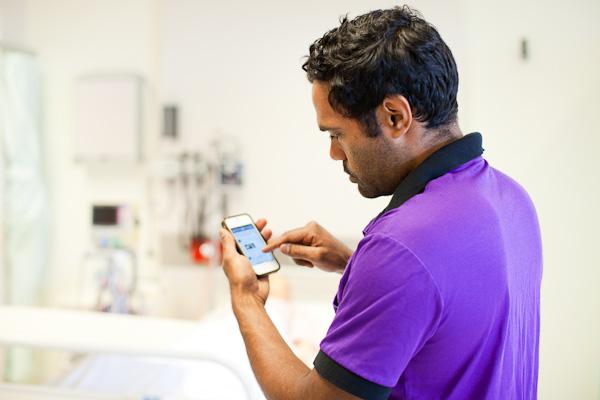
- If you carry your smartphone with you everywhere, then the data it tracks could provide a comprehensive picture of your health – and alert you if it begins to deteriorate.
- Please note: Embedded links in this article will open external sites.
What if you could forecast sickness, before you even had any symptoms? Your smartphone and digital data might be able to help.
If you carry your smartphone with you everywhere, then it’s probably already tracking a lot of data about you and your behaviour. If you have a wearable device, you’ll be generating a multitude of fitness data too. Put it all together and you get your “digital phenotype” – a comprehensive picture of your health and well-being, kind of like a digital jigsaw puzzle.
When collated with data obtained from clinical assessment, such as blood tests and diagnostic imaging, it could generate valuable insights for health professionals to inform care planning. And there is increasing evidence that web data can be useful to digitally detect disease, and predict suicide, influenza outbreaks or new cases of HIV.
What do your digital devices know about you?
As you get out of bed, your smartphone captures your usual time of waking, and possibly the amount and quality of sleep you had that night. If you commute to work, it captures your journey – as well the amount of time spent sitting or standing during that travel period – via GPS and geographical data.
Over the course of the day, it tracks your physical activity – distance walked or climbed, standing time, and an estimate of the exercise undertaken and energy expended – via accelerometers.
You might have logged your medical history, diet and weight data through an app or a smart scale. Your heart rate and rhythm could be recorded via your smart watch. Your device usage, including screen time and internet browsing history, is captured by your phone itself, or via various apps you may have downloaded.
How could this information help?
Take the example of chronic heart failure. An estimated 480,000 Australians are living with this common and burdensome cardiovascular condition, which is increasingly prevalent among older adults. It’s also common for these individuals to live with other health conditions.
While heart failure is a progressive and terminal condition, there are often signs and symptoms preceding periods of deterioration. These include ankle or leg swelling (oedema), shortness of breath (dyspnoea), fatigue, and reduced capacity for exercise.
If someone living with heart failure was being monitored via a smartphone, the data could highlight increasingly disrupted sleep patterns, reduced physical activity, changes in weight, and irregularity in vital signs, such as heart rate. These changes in a persons daily functioning would clearly indicate a deteriorating condition that should, ideally, trigger a visit to their nurse, GP or emergency department.
Taking it a step further, the changes could trigger an alert to a health professional, allowing timely clinical assessment and intervention. This would not only save significant health costs, but improve symptom management and unwanted deterioration.
Are health professionals using this information?
Globally, the population is living longer and with multiple chronic health conditions. But few health care professionals are currently tapping into the digital phenotype to inform clinical decisions.
There isn’t a lot of education about how to access these data, or how to routinely apply it within a practice, at the bedside or in the clinic. Protocols, procedures and platforms for collecting, analysing and integrating these data into medical record systems aren’t common either.
Some forms of remote health monitoring already exist. For example, telehealth and telemonitoring systems allow clinicians to remotely deliver health care via telephone and web-based platforms. But their uptake in routine clinical care has been relatively slow – perhaps because it requires both patients and clinicians to manually log data. This is in contrast to the kind of passive data collection that occurs with smartphone and wearable devices.
The next frontier of health care
We urgently need innovative models of health care that support patient monitoring in those with chronic conditions, and the early detection of symptoms. That means establishing data feedback loops between patients and clinicians. Passive data collection via smartphones and wearable devices may provide monitoring technology as a low cost, accessible solution that doesn’t put a huge burden on the provider and patient for data input.
It is critical to embed these technologies within the existing medical data and electronic medical record systems. But these technologies present complex clinical, legal, ethical and health systems challenges.
Patients must consent to health professionals accessing and using their personal digital data to inform their healthcare. There must be data security all along the chain. And we must not overlook value of a direct and personal relationship between the patient and clinician.
Monitoring data alone cannot improve outcomes, but it may be used to identify deterioration in the patients condition and thereby enable timely clinical assessment and intervention.
Byline: Dr Caleb Ferguson and Associate Professor Sally Inglis
This article was originally published on the Conversation. Read the original article.

